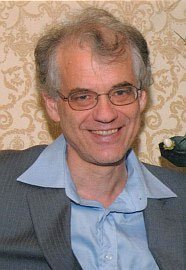16th Annual Wolff Memorial Lecture

Mikhail Lyubich, Professor of Mathematics
Lecture 1 - Tuesday, January 31, 2017 at 4 PM in 151 Sloan
Lecture 2 - Thursday, February 2, 2017 at 4 PM in 151 Sloan
Lecture 3 - Monday, February 6, 2017 at 4 PM in 151 Sloan
Lecture 1 (General Lecture)
Title: Dynamics of Quadratic Polynomials, Complex and Real
Dynamics of quadratic polynomials, real and complex, has been an area of active research since the late 1970s. Over the complex, it is described by beautiful fractal objects, like Julia sets and the Mandelbrot set M, exhibiting surprising universal features. Over the reals, it exhibits an intricate intertwining between regular and chaotic dynamical regimes. Many of these features are related to the Renormalization phenomenon that controls small scale structure of the dynamics. By now, there is a thorough understanding of this area, though some deep problems are still awaiting for resolution. In the talk, we will give an overview of this field over the 40 years period, starting with the definition of a quadratic polynomial (z^2+c) and a description of the Douady-Hubbard-Thurston topological model for M.
Lecture 2
Title: Renormalization and Universality
Renormalization is an operator that relates the dynamics in various scales. Good control of this operator usually implies remarkable dynamical consequences, e.g., the universal shape of little M-copies. However, it is a difficult problem to gain such a control. We will outline a proof of the Feigenabaum-Coullet-Tresser Renormalization Conjecture, based upon Sullivan's, McMullen's and author's work from the 1990s.
Title: Regular or Stochastic Dichotomy
There are two types of the dynamics observed in the real quadratic family: regular dynamics governed by a unique attracting cycle, and stochastic dynamics governed by a unique absolutely continuous invariant measure. We will outline a proof of the Regular or Stochastic Dichotomy that asserts that almost any real quadratic map z^2+c, c\in [-2, 1/4], is either regular or stochastic, which gives a complete probabilistic picture of the dynamics in this family. The proof exploits the Yoccoz Puzzle and the Renormalization machineries. Based upon author's work from the 1990s.
Lecture 3
Title: Advances towards MLC
The first example of a bounded, complete minimal surface was given in the 1970's (PJ). Since then several new types of such surfaces have been shown to exist. I will discuss recent research (PJ) showing that there exists a new type of example, namely a complete, bounded Legendrian disk in C^3. This means there are two bounded holomorphic functions (F, G) on the unit disk such that (F(z), G(z),z) is a complete, bounded minimal surface, with the property that, setting H'(z) = F(z)G'(z), H is also a bounded holomorphic function. The construction uses a modification of Uchiyama's method of decomposing BMO functions into u + H(v), where u and v are bounded functions. I will also discuss some open problems in this area.
Title: Area and Hausdorff Dimension of Julia Sets
Fractal sets in the plane can be roughly classified according to the following Geometric Trichotomy:
Lean Case: HD(J)< 2;
Balanced Case: HD(J)=2 but area(J) =0;
Black Hole Case: area(J)>0.
We will overview this Trichotomy in the context of Julia sets. In particular, we will show that all three cases can be realized in the class of Feigenbaum Julia sets. Based upon a recent joint work with Artur Avila.
Getting to Caltech:
Caltech's address is 1200 E. California Blvd., Pasadena, CA 91125. Turn south on the unnamed street between the tennis courts and burnt orange geometric building to access the underground parking structure, that is Lot 3 on the event map. Please visit a yellow pay station kiosk to purchase a parking pass ($3 for two hours). Make sure the ticket is clearly visible on your dashboard to avoid a ticket. After you have parked, head north and cross the street. The Sloan Building will be the first one on the right, building 37.



